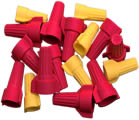How an Electric Light Switch Works
Light switches are simple in design. Current flows through a switch to the load, such as a ceiling light. When you flip the switch off, it breaks the circuit and interrupts the flow of electricity. A basic light switch has two terminals and sometimes a ground terminal. The hot wire from the power source is connected to one of the terminals. The hot wire going to the load (such as a light) is connected to the second terminal.
Caution: Please read our safety information before attempting any testing or repairs. References to existing wiring assume that it is properly wired, which may not be the case in your home.
Which Wires Get Connected to the Switch?
There is a safe and correct way to wire a switch. Some people wonder "what difference does it make which wire gets connected?" While it is true that wiring the hot or the neutral wire to the switch will both break the circuit, only wiring the hot wire will do it safely. If you interrupt the hot wire at the switch, the power stops at the switch and can flow no farther. The light, outlet or whatever is connected to the switch will not be energized. If you wire the neutral wire to the switch, it does also break the circuit at the switch. However the hot wire goes through to the load, and from there current flow to ground. For instance, imagine a light socket with the hot wire connected to it and the neutral wire to the switch. When you turn off the switch, the circuit is broken and the light goes off. However, with the light switch off, unscrew the light bulb and stick your finger in the light socket and current can flow through you to ground, which would be bad. That would not happen if the neutral wire was connected to the light and the hot wire to the switch when the switch is off. By interrupting the hot wire at the switch instead of the neutral in a properly wired circuit, you have stopped the current before it passes through the load.
Do I Need to Replace my Light Switch?
When a light switch fails, symptoms can include a loose or wobbly switch or it may be stiff or difficult to push. Lights that flicker may indicate a switch that is shorting. A switch that has failed completely will fail to turn on or in rare cases fail to turn off a circuit.
If you do need to replace a wall switch, it is fairly easy to do yourself. Here is an article describing How To Replace a Light Switch and How To Replace a 3-Way Light Switch.





